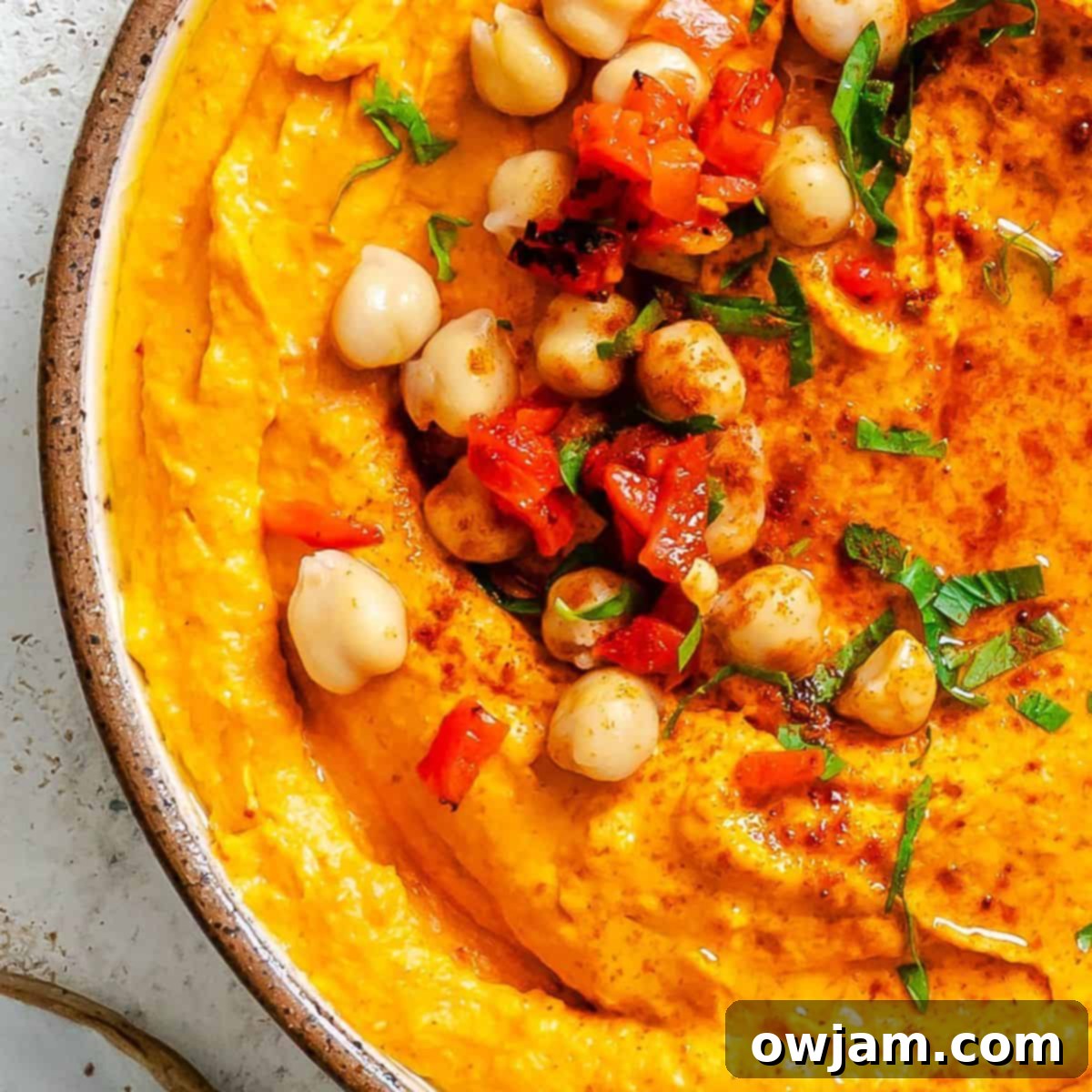Mastering Homemade Roasted Red Pepper Hummus: A Guide to Creamy, Flavorful Mediterranean Perfection
Elevate your snacking and dining experience with this incredibly flavorful Roasted Red Pepper Hummus recipe. Roasted peppers transform traditional hummus into a vibrant, smoky, and slightly sweet dip that’s not only delicious but also packed with healthy ingredients. This versatile spread is perfect for enhancing wraps and sandwiches, serving as a delightful dip for your favorite crudités or pita bread, or forming the cornerstone of a nutritious hummus bowl. Get ready to discover your new favorite go-to recipe for a taste of the Mediterranean!
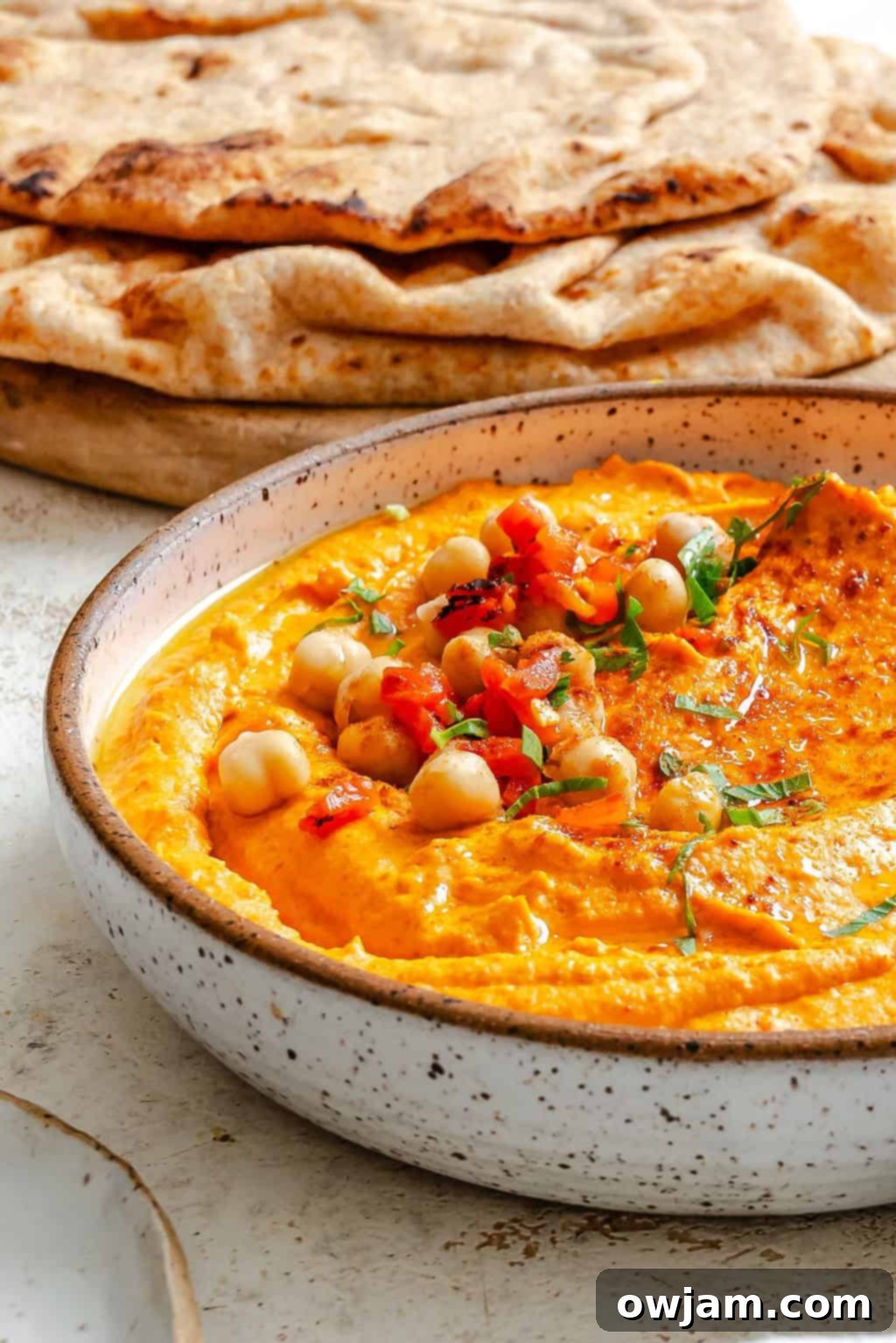
This Roasted Red Pepper Hummus recipe isn’t just about food; it’s a journey back to cherished childhood memories. I vividly recall gathering around the kitchen table, the air filled with laughter and lively conversations, while sharing homemade hummus with the people I hold dearest. This tradition, steeped in Lebanese culture from my Mom’s side of the family, taught me the profound connection between food, family, and heritage.
When asked about the Lebanese customs that shaped my upbringing, I always emphasize cooking and the central role of food. It was, and still is, a cornerstone of our family life. And when you speak of Lebanese cuisine, it’s impossible not to talk about hummus – a staple that embodies the warmth, generosity, and vibrant flavors of the Middle East.
While store-bought options are convenient, we consistently prefer homemade hummus. The ability to control every ingredient allows us to tailor the flavor and consistency to perfection, ensuring a fresh, wholesome, and deeply satisfying dip every time. This control also means we can avoid unwanted preservatives and adjust for any dietary preferences, making it a healthier choice for everyone at the table.
Hummus transcends its role as a simple dip in our household. It’s our absolute favorite for any occasion: a quick, healthy snack, an inviting appetizer to kick off a meal, a delightful side dish to complement grilled meats, or even a robust main meal when paired with grilled chicken, savory lamb, or traditional kibbeh. Its creamy texture also makes it an excellent spread for sandwiches, adding a layer of rich flavor and satisfying protein.
If you’re a hummus enthusiast, you’ll definitely want to explore more of our recipes. Be sure to try my Easy Beet Hummus for a vibrant twist, our classic Easy Lebanese Hummus, the impressive Hummus Platter for entertaining, and the zesty Spicy Hummus for those who crave a kick.
Essential Ingredients for Perfect Roasted Red Pepper Hummus
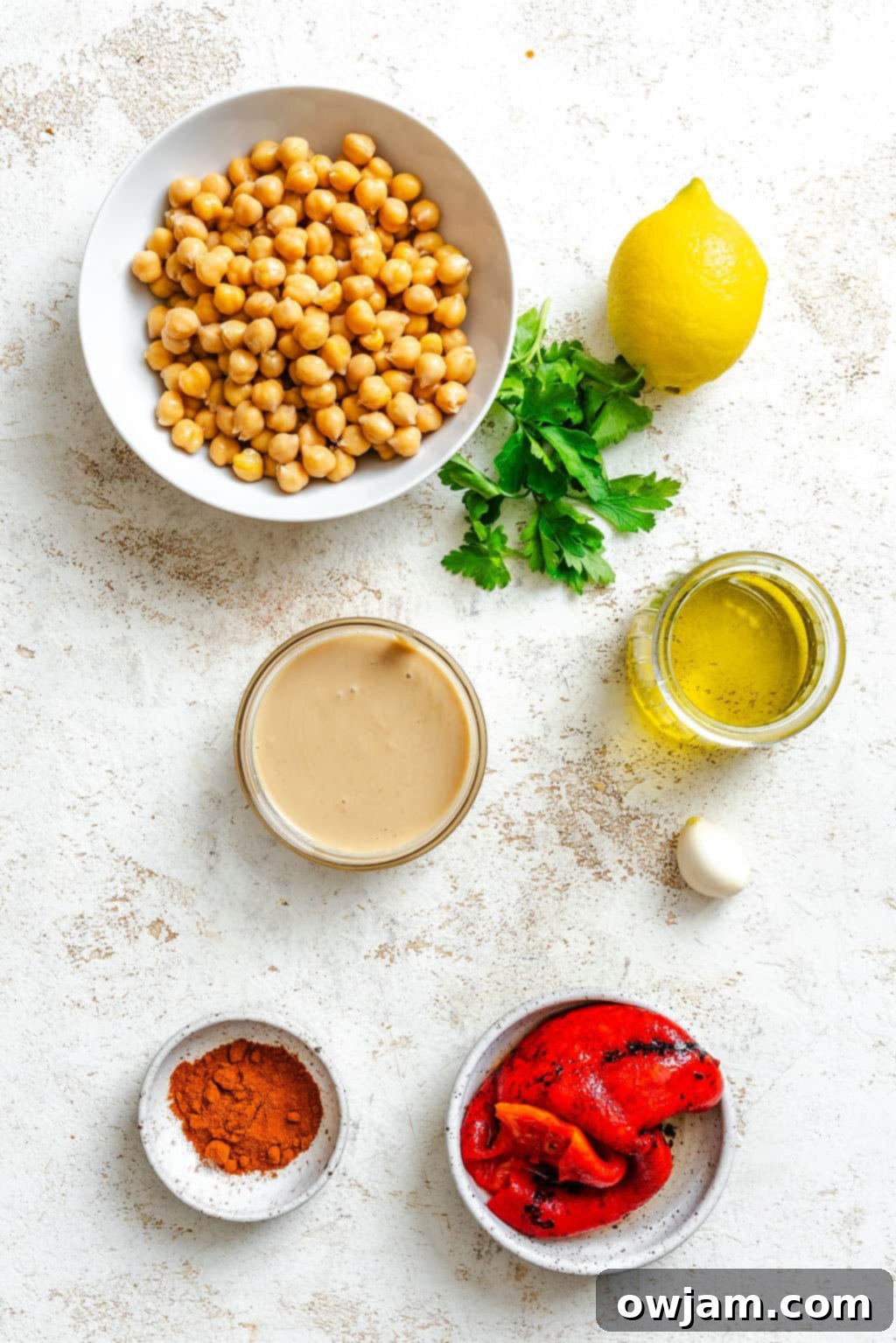
Creating sensational hummus starts with quality ingredients. Here’s a breakdown of the simple yet essential components for our roasted red pepper hummus. For precise measurements and step-by-step instructions, be sure to check the full recipe card below.
- Chickpeas (Garbanzo Beans): These legumes are the heart and soul of any hummus. I opt for canned chickpeas for convenience, ensuring they are thoroughly drained and rinsed before use. A pro tip for extra creamy hummus is to save some of the aquafaba (the liquid from the can) to thin out your hummus if needed, or even better, remove the skins from the chickpeas for an exceptionally smooth texture.
- Roasted Red Peppers: The star of this specific hummus variation! I typically use jarred roasted red peppers for their consistent quality and readiness. They impart a beautiful smoky, sweet, and tangy flavor that perfectly complements the earthiness of the chickpeas. If you prefer, you can also roast your own red peppers at home for an even fresher taste.
- Lemon: Fresh lemon juice is crucial for that bright, zesty tang that balances the richness of the hummus. Don’t skip the fresh stuff; bottled lemon juice simply doesn’t compare. A little lemon zest can also intensify that delightful citrus aroma.
- Tahini: This creamy paste, made from ground sesame seeds, is indispensable for authentic hummus. It provides a distinct nutty flavor and contributes significantly to the smooth, buttery consistency that sets hummus apart. Think of it as the peanut butter of the Middle East, though with a more savory and slightly bitter note. You’ll typically find tahini in the international or Middle Eastern section of your grocery store. For best results, stir your tahini well before measuring, as the oil can separate.
- Garlic: Fresh garlic cloves are key to building the aromatic foundation of your hummus. While not strictly necessary for the structural integrity of hummus, it adds an incredible depth of pungent, savory flavor. Adjust the quantity to your preference – some like it subtle, others prefer a bold garlic punch. For a milder, sweeter garlic flavor, consider using roasted garlic instead of raw.
- Olive Oil: Extra virgin olive oil is my top recommendation for its robust flavor and health benefits. It not only helps achieve a silky-smooth texture but also lends a fruity, peppery note. Regular olive oil or even a neutral avocado oil can be used as alternatives, but extra virgin provides the best flavor profile. A final drizzle over the finished hummus before serving adds a beautiful sheen and richness.
Creative Ways to Customize Your Roasted Red Pepper Hummus
One of the joys of making homemade hummus is the freedom to experiment with flavors and textures. Don’t be afraid to get creative and tailor this recipe to your palate!
- Spice it Up: Introduce a new dimension of flavor with aromatic spices. Try adding a pinch of smoked paprika for an extra smoky depth, ground cumin for an earthy warmth, or a blend of Greek seasoning for a Mediterranean kick. Cumin is particularly good with chickpeas, enhancing their natural flavor.
- Fresh Herbs: Brighten up your hummus with the addition of fresh herbs. Finely chopped fresh parsley or cilantro can add a refreshing, herbaceous note. For a unique touch, consider fresh dill or mint, especially if serving with fresh vegetables. Herbs can be blended directly into the hummus or used as a vibrant garnish.
- Add Some Heat: For those who love a spicy dip, there are many ways to introduce heat. Stir in a teaspoon of harissa paste for a North African chili kick, a sprinkle of crushed red pepper flakes for an easy spice boost, a dash of cayenne pepper, or even blend in some fresh or pickled jalapeños for a fresh, fiery flavor.
- Flavorful Garnishes: Beyond a simple drizzle of olive oil, garnishes can transform your hummus both visually and texturally. Sprinkle with toasted pine nuts, a handful of chopped walnuts, or even some crumbled feta cheese. For a fresh crunch, add finely diced cucumber, bell peppers, or cherry tomatoes. Don’t forget our favorites: quick pickled red onions or a medley of pickled vegetables for a tangy contrast. A sprinkle of za’atar or sumac can also add authentic Middle Eastern flavors.
- Extra Creaminess: If you desire an even richer, silkier hummus, consider adding a tablespoon or two of Greek yogurt (if not strictly vegan) or a little extra tahini. Blending in a few ice cubes can also help achieve a super light and airy texture.
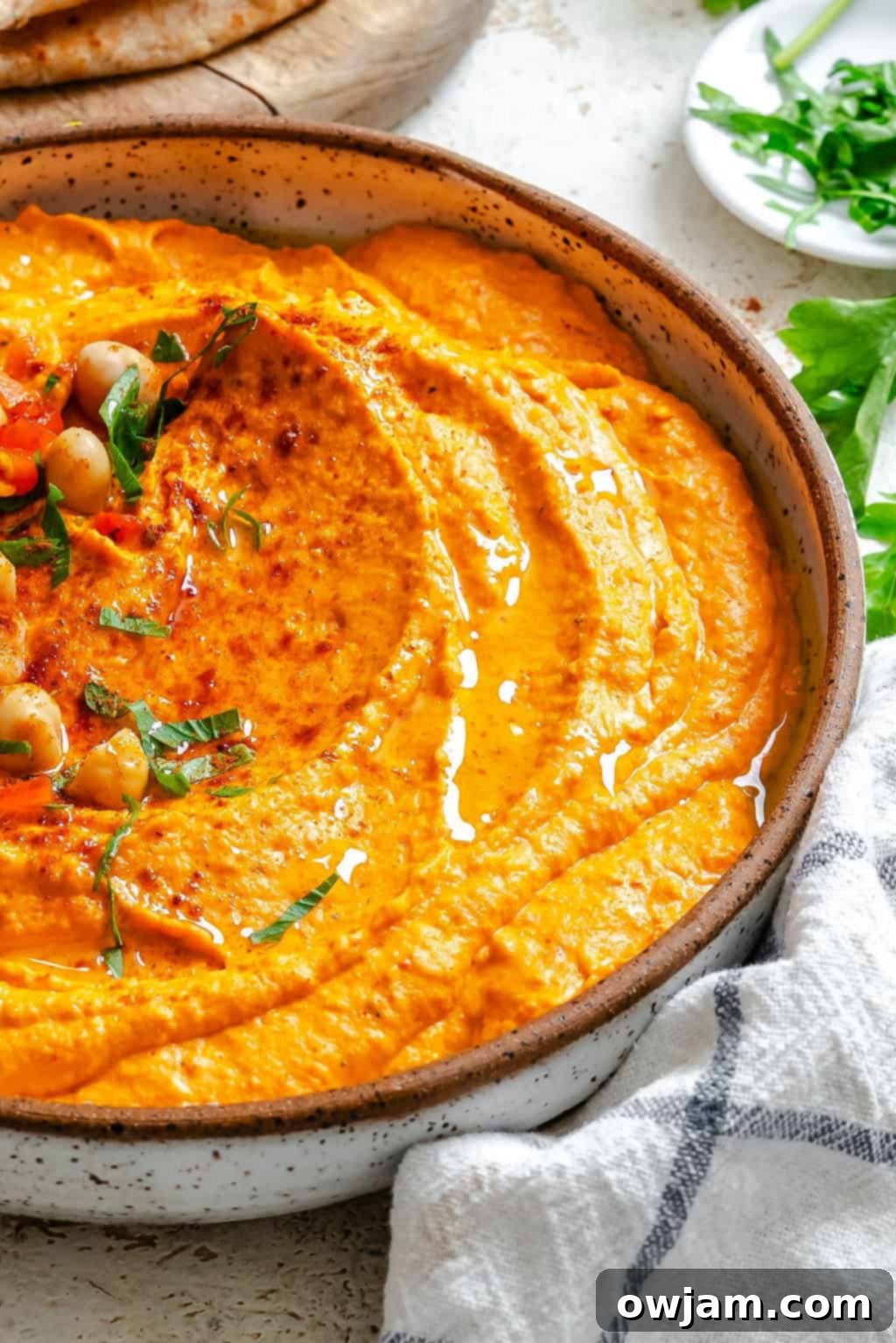
Crafting Your Creamy Roasted Red Pepper Hummus: A Simple Guide
Making homemade hummus is surprisingly easy and incredibly rewarding. Follow these steps to achieve that perfect, creamy consistency and rich flavor.
Step 1: Prepare Your Ingredients for Optimal Flavor
Before blending, ensure all your ingredients are ready. Drain and thoroughly rinse your canned chickpeas; this removes excess sodium and any canning liquid flavor. If you’re going for ultra-creamy hummus, consider gently rubbing the chickpeas between paper towels or simmering them with a pinch of baking soda to loosen and remove the skins. This extra step makes a noticeable difference in texture. Squeeze your fresh lemon juice, measure your tahini (stir well first!), and roughly chop your garlic cloves.
Step 2: Blend to Perfection for Unbeatable Creaminess
Place all your prepared ingredients—chickpeas, roasted red peppers, lemon juice, tahini, garlic, and a initial pour of olive oil—into a high-speed food processor. Begin processing for about 60 seconds. During this time, stop the processor once or twice to scrape down the sides with a spatula. This ensures all ingredients are thoroughly incorporated and blended evenly. Continue blending until the mixture is completely smooth and creamy. The longer you blend, the smoother your hummus will be. For an even lighter, fluffier texture, you can slowly drizzle in a tablespoon or two of ice water while the processor is running.
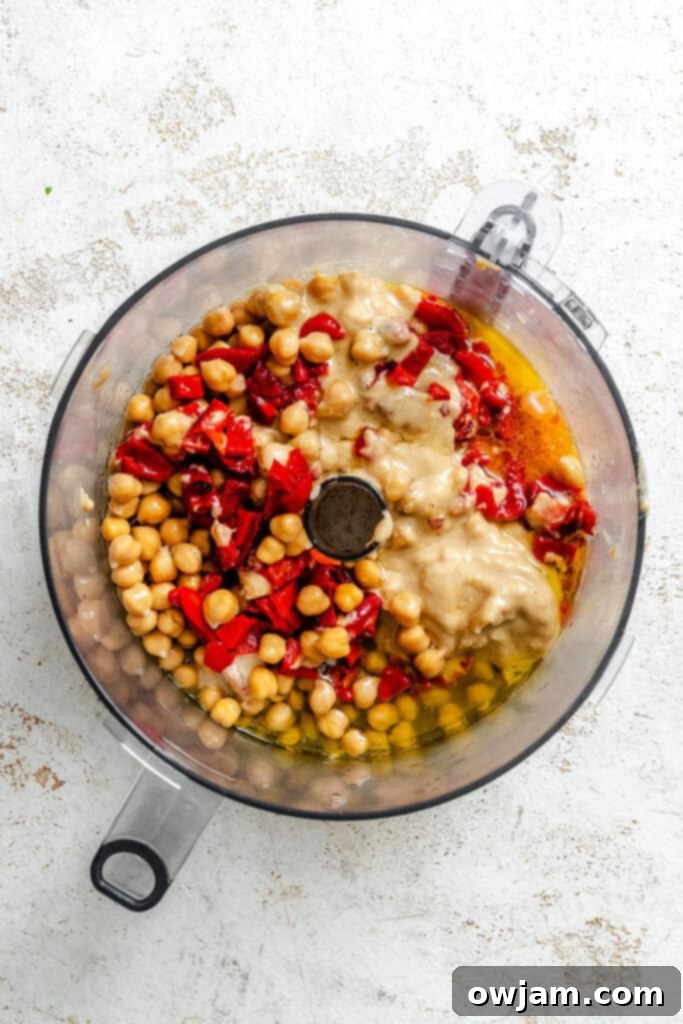
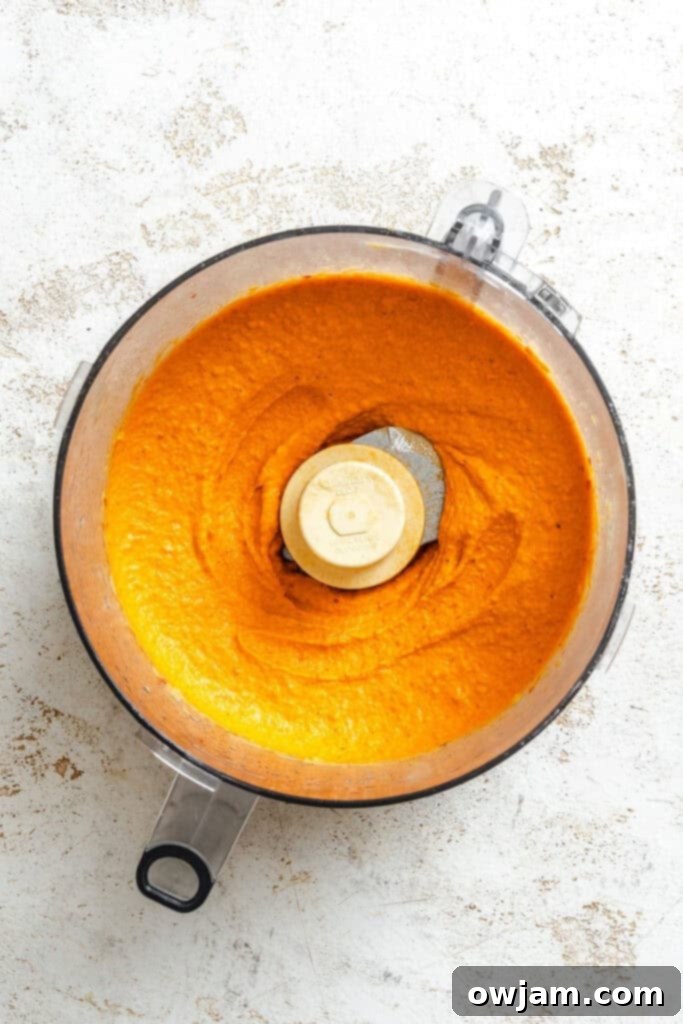
Step 3: Taste and Adjust for Your Perfect Flavor Profile
Once your hummus reaches a creamy consistency, it’s time for the most important step: tasting and adjusting! Spoon a small amount to taste. Does it need more salt? A touch more lemon juice for brightness? Perhaps another clove of garlic? Feel free to fine-tune the flavors to your liking. If your hummus is too thick, turn the food processor back on and slowly add small amounts of the reserved chickpea liquid (aquafaba), cold water, or a little more olive oil, until you achieve your desired silky-smooth consistency.
Step 4: Present and Garnish Your Homemade Delight
Once perfected, use a spatula to scrape the homemade hummus into a shallow serving bowl. Create a small well in the center using the back of a spoon. Drizzle a generous amount of high-quality extra virgin olive oil over the top; this not only adds flavor but also helps to keep the hummus moist and appealing. For a beautiful presentation, garnish with a sprinkle of freshly chopped parsley, a dash of paprika or sumac, and a few whole roasted red pepper strips or chickpeas. Serve immediately with warm pita bread, fresh vegetable sticks, or your favorite crackers. Leftovers can be refrigerated for later enjoyment.
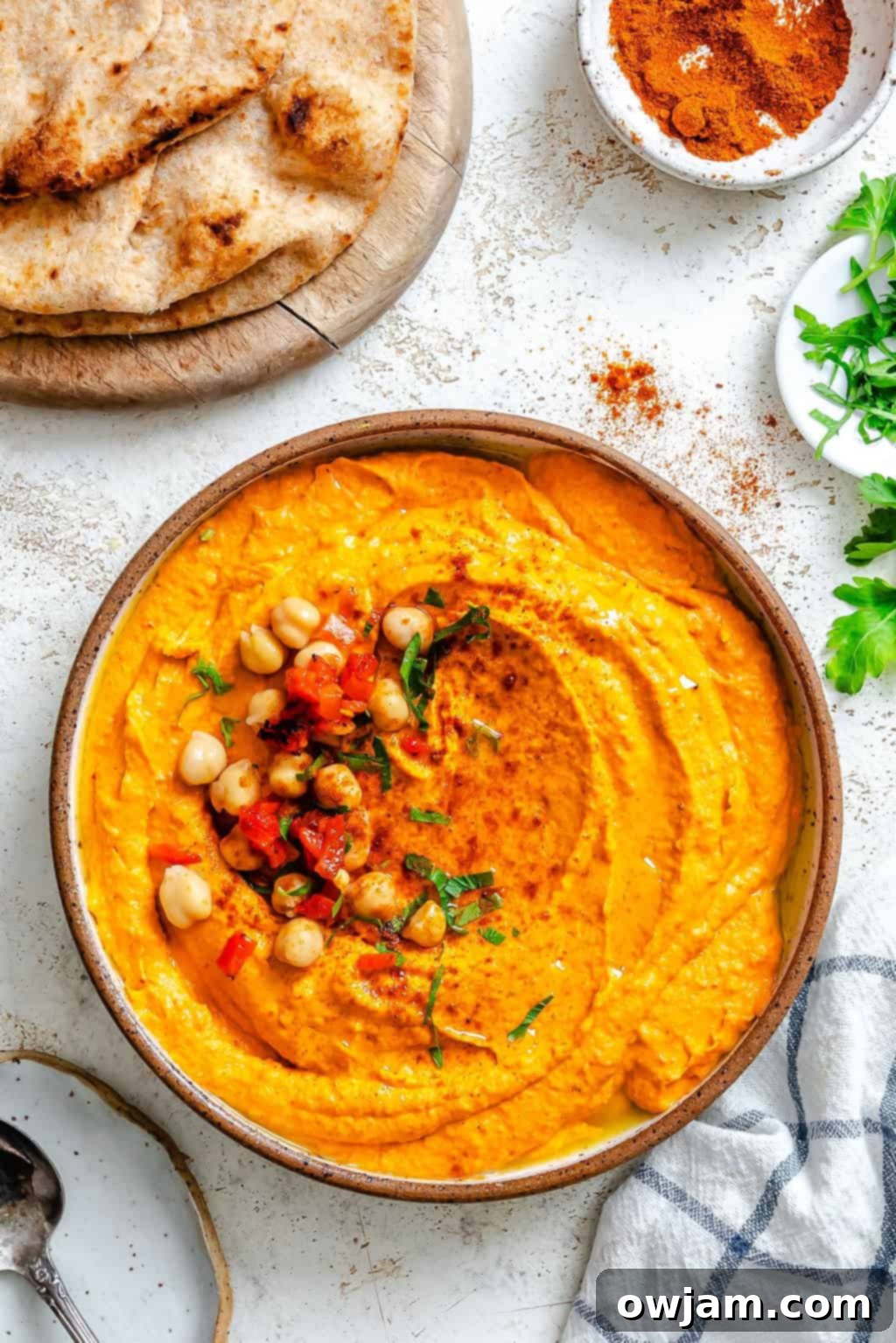
Storage & Meal Prep Tips for Your Hummus
Homemade hummus is fantastic for meal prepping and can be enjoyed for days after preparation. Proper storage ensures its freshness and flavor last as long as possible.
Refrigerating Hummus:
You can store freshly made hummus in an airtight container in the refrigerator for up to 5 to 7 days. To help preserve its freshness and prevent it from drying out, it’s a great idea to drizzle a small amount of extra virgin olive oil over the surface of the hummus before sealing the container. This creates a protective barrier that keeps the hummus moist and flavorful.
Freezing Hummus for Longer Storage:
Yes, you absolutely can freeze hummus! This is perfect for making larger batches or extending its shelf life. Transfer the hummus to an airtight, freezer-safe container, leaving about an inch of space at the top to allow for expansion during freezing. It can be stored in the freezer for up to 3 months. When you’re ready to enjoy it, thaw the hummus overnight in the refrigerator. Before serving, give it a good stir, as the texture might separate slightly during the thawing process. If it seems a bit thick, simply add a splash of cold water or a little more lemon juice and stir until it returns to its creamy consistency.
Tips for Maximum Freshness:
- Always use a clean spoon each time you scoop hummus to prevent contamination.
- Store in the coldest part of your refrigerator.
- If the top layer looks discolored after a few days, simply scrape it off, and the hummus underneath should still be good.
Frequently Asked Questions About Homemade Hummus
Got questions about making the perfect creamy hummus? We’ve got answers!
Achieving that silky-smooth texture is key to exceptional hummus. The most impactful tip is to remove the skins from the chickpeas. You can do this by rubbing them gently between a kitchen towel, or for canned chickpeas, simmer them in water with a small pinch of baking soda for 10-15 minutes – this softens them considerably and makes the skins slip off easily. Another secret for an ultra-light and smooth hummus is to drizzle in small amounts of ice water or reserved chickpea liquid (aquafaba) while the food processor is running. Finally, don’t rush the blending process; let your food processor or high-speed blender run for several minutes (up to 5 minutes) to fully emulsify all the ingredients and break down the chickpeas.
While it’s possible to make a chickpea dip without tahini, it won’t have the traditional, authentic flavor and characteristic richness of true hummus. Tahini is essential for that signature nutty taste and creamy consistency. However, if you have a sesame allergy or simply don’t have tahini on hand, you can substitute it with Greek yogurt for a tangier, lighter dip, or use smooth nut butters like almond butter or cashew butter for a similar fatty richness, though the flavor profile will differ significantly.
If your hummus is thicker than you’d like, don’t worry – it’s an easy fix! While blending, gradually add more liquid until you reach your desired consistency. You can use extra lemon juice for added brightness, cold water for thinning without altering flavor, or a bit more olive oil for extra richness. Slowly adding the reserved chickpea liquid (aquafaba) is also an excellent way to thin it out while adding flavor and body.
Absolutely! Using dried chickpeas often results in an even creamier and more flavorful hummus, as you have more control over their cooking. To use dried chickpeas, soak them overnight in plenty of water. The next day, drain and rinse them, then simmer them in fresh water with a pinch of baking soda until they are very tender (about 1.5-2 hours). Ensure they are soft enough to easily mash between your fingers before proceeding with the recipe. This extra effort is well worth it for the superior texture and taste.
Yes, this recipe for Roasted Red Pepper Hummus is naturally both vegan and gluten-free. All the ingredients – chickpeas, roasted red peppers, lemon, tahini, garlic, and olive oil – are plant-based and do not contain gluten. This makes it a fantastic healthy option suitable for a wide range of dietary needs and preferences, perfect for sharing with friends and family.
Delicious Ways to Serve Your Homemade Hummus
Roasted Red Pepper Hummus is incredibly versatile and can be enjoyed in countless ways. Here are some of our favorite suggestions:
- Classic Dip: Serve alongside warm pita bread, pita chips, or an assortment of fresh crudités like cucumber slices, carrot sticks, bell pepper strips, celery, and cherry tomatoes.
- Hummus Bowls: Create a hearty and healthy meal by spreading hummus as the base in a bowl, then topping it with grilled chicken or falafel, chopped fresh vegetables (cucumber, tomato, red onion), olives, a sprinkle of feta (if not vegan), and a drizzle of olive oil.
- Sandwich and Wrap Spread: Ditch the mayonnaise! Hummus makes a fantastic, flavorful, and healthier spread for sandwiches and wraps. It adds moisture and a protein boost.
- Salad Topping: Dollop a spoonful of hummus onto your salads for an extra layer of creaminess and flavor. You can even thin it slightly with a little water or lemon juice to create a creamy salad dressing.
- With Grilled Meats or Vegetables: Serve as a side dish with grilled chicken, lamb kofta, fish, or alongside roasted or grilled vegetables like zucchini, eggplant, and asparagus.
- Breakfast Toast: Spread hummus on toasted sourdough or whole-grain bread, then top with avocado, a fried egg, everything bagel seasoning, or chili flakes for a savory and satisfying breakfast.
Discover More Hummus Recipes
Appetizers
Lebanese Style Hummus
Appetizers
Cucumber Hummus Bites
Beef
Hummus with Spiced Beef and Toasted Pine Nuts
Vegetarian
Mediterranean Hummus Toast with Za’atar
Tried this recipe? Leave a star rating and comment below! Subscribe to my newsletter or follow me on
Facebook,
Instagram, or
Pinterest for the latest.
Roasted Red Pepper Hummus
Julia Jolliff
10 minutes
10 minutes
4

Saved
Pin
Ingredients
- 1 -15 ounce can of chickpeas, drained and rinsed (save some liquid for thinning)
- juice of 1 lemon
- 1/3 cup tahini
- 1 or 2 cloves fresh garlic {adjust to your preference}
- 3 tablespoons extra virgin olive oil {plus extra for drizzling and thinning if desired}
- 3/4 cup chopped jarred roasted red peppers
- Salt to taste
- Optional garnishes: Fresh parsley, paprika/sumac, whole chickpeas, extra roasted red pepper strips, a final drizzle of olive oil
Instructions
-
1. Prepare Ingredients: Drain and rinse the canned chickpeas thoroughly. If desired, gently rub them between a kitchen towel to remove the skins for an extra creamy texture. Measure out all other ingredients.
-
2. Blend All Ingredients: Add the drained chickpeas, chopped roasted red peppers, fresh lemon juice, tahini, garlic cloves, and 3 tablespoons of extra virgin olive oil to a food processor.
-
3. Achieve Creaminess: Process the mixture for 1-2 minutes, stopping periodically to scrape down the sides of the food processor bowl. Continue blending until the hummus is completely smooth and creamy. For an even lighter consistency, you can slowly drizzle in 1-2 tablespoons of ice water or reserved chickpea liquid while the processor is running.
-
4. Taste and Adjust: Taste the hummus and adjust seasonings as needed. Add more salt, lemon juice, or garlic to your preference. If it’s too thick, add a bit more olive oil or cold water, blending until you reach the desired consistency.
-
5. Serve and Garnish: Transfer the finished hummus to a shallow serving bowl. Create a swirl or well in the center. Drizzle generously with extra virgin olive oil and garnish with chopped roasted red peppers, fresh parsley, and a sprinkle of paprika or sumac. Serve immediately with warm pita bread, fresh vegetables, or your favorite dippers.
-
6. Store Leftovers: Cover and refrigerate any leftover hummus in an airtight container for up to 5-7 days. Drizzling with a thin layer of olive oil on top can help preserve freshness.
Notes
- Storage: Store hummus in an airtight container in the fridge for up to 5-7 days. A drizzle of olive oil on top helps keep it fresh and prevents drying.
- Freezing: Hummus freezes beautifully! Transfer it to an airtight, freezer-safe container, leaving about an inch of headspace. Freeze for up to 3 months. Thaw in the fridge and stir well before serving. Add a splash of water or olive oil if needed to restore consistency.
- For Extra Creamy Hummus: To achieve the smoothest texture, consider removing the skins from the chickpeas. You can rub them between a kitchen towel after draining, or simmer canned chickpeas in water with a little baking soda for 10-15 minutes, then drain and rinse before peeling. Additionally, drizzling ice water into the food processor while blending can make the hummus extra light and smooth. Ensure your food processor runs for several minutes to fully emulsify all ingredients.
- Adjusting Thickness: If your hummus is too thick, simply add more lemon juice, cold water, or olive oil, a tablespoon at a time, until it reaches your preferred consistency.
Nutrition
Nutrition information is automatically calculated, so should only be used as an approximation.
Tried this recipe?
Mention @acedarspoon or tag #acedarspoon!
